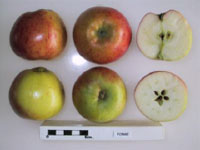History of the Forge apple
The apple is also known as Sussex Forge and arose at either Forge Farm or near old iron forges around East Grinstead. Robert Hogg described it in 1851, but by then it was well known. The variety is known as the “Cottagers Apple” and was widely grown in north Sussex and Surrey in the nineteenth century. It is still found around East Grinstead.
“A very old variety extensively cultivated throughout Sussex, where it is one of the most popular apples for dessert and cooking. This old variety still has many supporters,” wrote H.V. Taylor in 1948.
It is currently cultivated as part of Brighton Permaculture Trust’s National Collection in Stanmer Park, Brighton. You can see a Forge apple tree (planted 2011) in Home Farm Orchard, Stanmer Park ( map).
Description of fruit
Soon after picking, the Forge apple has a sharp tannic flavour but mellows to be almost rich, lightly aromatic. It cooks to a soft, lemon coloured purée which tastes quite brisk and fruity. It also makes good sauce.
The fruit is a pale green-yellow with a light orange flush and a little red. Medium in size, the Forge apple is conical to round conical, with a short thick stalk. Basin broad, quite deep; ribbed. Eye closed; sepals short, thick. Cavity narrow, shallow; little russet.
Season of use
Fruit can be picked late September and stored through December or even March if kept very cool.
Tree habit
The tree is a moderately vigorous grower. Hogg added: “It is a great and constant bearer.”
Notes on cultivation
The Forge apple tree is very resistant to scab.
Flowering and pollination
Flowering day: F15
How to identify a Forge apple
Apples can be identified by sending them to the National Fruit Collection at Brogdale or by bringing a sample to Apple Day Brighton, where an expert pomologist will be on hand to identify apples. From each tree, bring three or more ripe fruits and a shoot with representative leaves.
Where to buy a Forge apple tree
Please contact us for details of our supplier for Sussex apple varieties.
